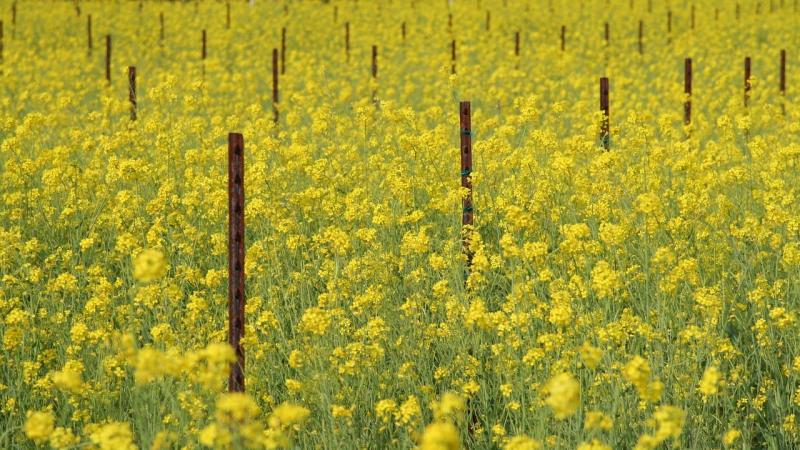
Many an actor has pranced through fields of gold in Indian films. Here’s a lesser known fact—thousands of hungry insects—the mustard aphids—feed on these golden-yellow cultivations of rape-seed mustard, causing an annual loss of 35-91% of the yield! In a recent study, researchers from Bose Institute, Kolkata, have investigated the effect of air circulation and the varying climatic conditions on the mustard aphids that migrate across the Indo-Gangetic Plains in Northern India. Perhaps, for the first time, the authors have traced the pests’ exact origin by studying the backward courses of air movement along known migratory routes.
Mustard aphids (Lipaphis erysimi), pearl-shaped tiny insects, have an interesting life cycle. Until the onset of winter, they remain in their early developmental stages, feeding on plants other than mustard. As the temperature falls in the Himalayas, during November, the aphids begin their long journey towards the upper Gangetic Plains, where the temperature is conducive to infest crops and wreak havoc. By mid-December, they move to the middle-plains and are then found raiding crops in the lower-plains by late December or early January.
Coincidentally, mustard, a Rabi crop cultivated in the winter, will have fully bloomed by the time these insect migrants arrive, providing adequate nutrition and favourable conditions to survive in these locations. While this clearly establishes the occurrences of the pests down the Indo-Gangetic Plains, it does not answer one question—from where do mustard aphids come?
The movement of air plays a crucial role in the migratory patterns of mustard aphids. Years of observations show that their migrations in the Gangetic Plains occur in the same week each year. In the current study, the researchers dug deeper into this fascinating, time-dependent phenomenon by looking into air circulation for the past 24 hours in sites where aphids invasions occur. The findings of the study were published in the journal Scientific Reports and the study was funded by the Department of Science and Technology (DST) and the Council for Scientific and Industrial Research (CSIR).
The researchers began their investigation from Mohanpur in West Bengal, where the pests generally appear in the first week of January. Working backwards, they identified Berhampur, Allahabad, and Meerut in the lower, middle and upper Gangetic Plains respectively, as source areas for aphid populations.
Interestingly, the researchers noticed that air drafts drive a huge population of aphids from the Western Himalayas towards the Indo-Gangetic Plains every November. “Even though the Eastern Himalayas are much closer to the Upper Plains than their Western counterparts, aphids in the east are either predated upon or washed away during monsoons and cannot make their annual migrations”, report the researchers. Hence, Western Himalayan regions, mainly Jammu and Kashmir, are the likely spot where aphids originate!
The researchers propose that the aphids ‘hop and fly’ from the Western Himalayas into the Upper Plains (Meerut) and continue towards the mid-plains in two possible ways. They either enter into the lower regions via Allahabad or follow a second path through the Terai landscapes of the Eastern Himalayas, which may also act as a source for pest invasions into West Bengal and Bangladesh.
Previous studies have established that aphids migrate to avoid freezing temperatures, and presumably to ensure that their offspring survive harsh winters. “But, the pest populations peaked and sustained for longer periods in the Upper Gangetic Area compared to the lower and mid regions”, say the researchers. A possible reason for this, they suggest, is that the insects head back to the hills only by February, once temperatures begin to warm up the Upper Plains. The backward migration is the aphid’s survival strategy, to sustain a population in the hills for future crop infestations. The aphids’ appearances in Kashmir during the month of March have backed this theory.
Indian farmers usually cultivate mustard between September and March. It takes about two months for the plant to bloom fully and this, unfortunately, is when insects attack. Agriculturalists have unsuccessfully attempted to dodge pest infestation by cultivating mustard early. The researchers recommend reversing cultivation periods in the three different regions of the Indo-Gangetic Plain. The absence of mustard crop in the Upper Plains in November would disallow the aphids’ ‘hop and fly’ migration between their source and the Lower Plains.
The researchers suggest that reversing cultivation periods could also prevent damages to other plants such as cauliflower, cabbage and broccoli belonging to the mustard family. Since mustard aphids have been reported to feed on all plants belonging to the mustard family, they propose cultivating these crops in a reverse manner altogether. However, to prove that this strategy will work, a large-scale study that covers many sites across the Indo-Gangetic plain would be needed.






